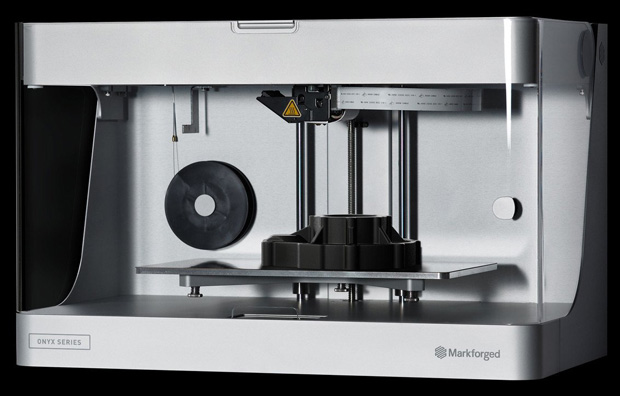Editor’s Pick: Markforged Onyx Series

Markforged recently introduced its Onyx Series of desktop 3D printers. Onyx Series printers work with the company’s Onyx filament, which, Markforged says, consists of chopped carbon fiber within nylon and provides twice the strength and stiffness of pure plastic. Image courtesy of Markforged Inc.
Latest News
December 21, 2016
In the scheme of things, it didn’t take 3D printing long to cozy into the engineer’s tool kit. Real 3D printing on your desktop, however, took a little longer to get going. But today’s Pick of the Week makes it evident engineering-quality 3D printing on your desktop is real.
The newly released Onyx series of 3D desktop printers are the first from Markforged to be plastic-only. But that’s a footnote about these affordable units.
These 3D printers work with Markforged’s similarly named Onyx filament, which apparently has become the company’s best-selling material in the short time it’s been available. Onyx material is made of chopped carbon fiber within nylon. Markforged says this composition gives it twice the strength and stiffness of pure plastic.Onyx-printed parts have a carbon black finish. The material, depending on what you’re doing, is designed for end-use applications. It’s also described as suitable for making prototypes with a finished look without making you fuss with a bunch of post-processing.
The series has two models: The Onyx One and the Onyx Pro. Both have a good-sized 12.60x5.20x6.05 in. (320x132x154 mm) print volume and a 100-micron Z layer resolution. The difference is that the Pro version sports dual printheads. The second printhead gives your parts continuous fiberglass reinforcement, which boosts the strength of the Onyx material 5 times, according to Markforged. If your needs change and you could use the fiberglass composite parts, you can field-upgrade the Onyx One with the second printhead.
Both 3D printers come with the company’s cloud-based file management and slicer software. It’s called Eiger. With the Onyx Series introduction Eiger has been updated with a new Turbo Print speed setting that can speed up making some parts by up to two times faster than previous versions of the software without any degradation of surface quality or resolution.
 Markforged recently introduced its Onyx Series of desktop 3D printers. Onyx Series printers work with the company’s Onyx filament, which, Markforged says, consists of chopped carbon fiber within nylon and provides twice the strength and stiffness of pure plastic. Image courtesy of Markforged Inc.
Markforged recently introduced its Onyx Series of desktop 3D printers. Onyx Series printers work with the company’s Onyx filament, which, Markforged says, consists of chopped carbon fiber within nylon and provides twice the strength and stiffness of pure plastic. Image courtesy of Markforged Inc.Affordable: That means 3500 doremis for the Onyx One and 7k for the Onyx Pro. Prices include Eiger software and starter materials.
The Onyx series desktop 3D printers sound pretty neat. And that Eiger software seems pretty neat too. There’s a link to a dedicated page about it at the end of today’s Pick of the Week write-up. Click today’s link to learn some more about the Onyx series. Seems well worth it.
Thanks, Pal. – Lockwood
Anthony J. Lockwood
Editor at Large, DE
Subscribe to our FREE magazine, FREE email newsletters or both!
Latest News
About the Author
Anthony J. Lockwood is Digital Engineering’s founding editor. He is now retired. Contact him via [email protected].
Follow DE







